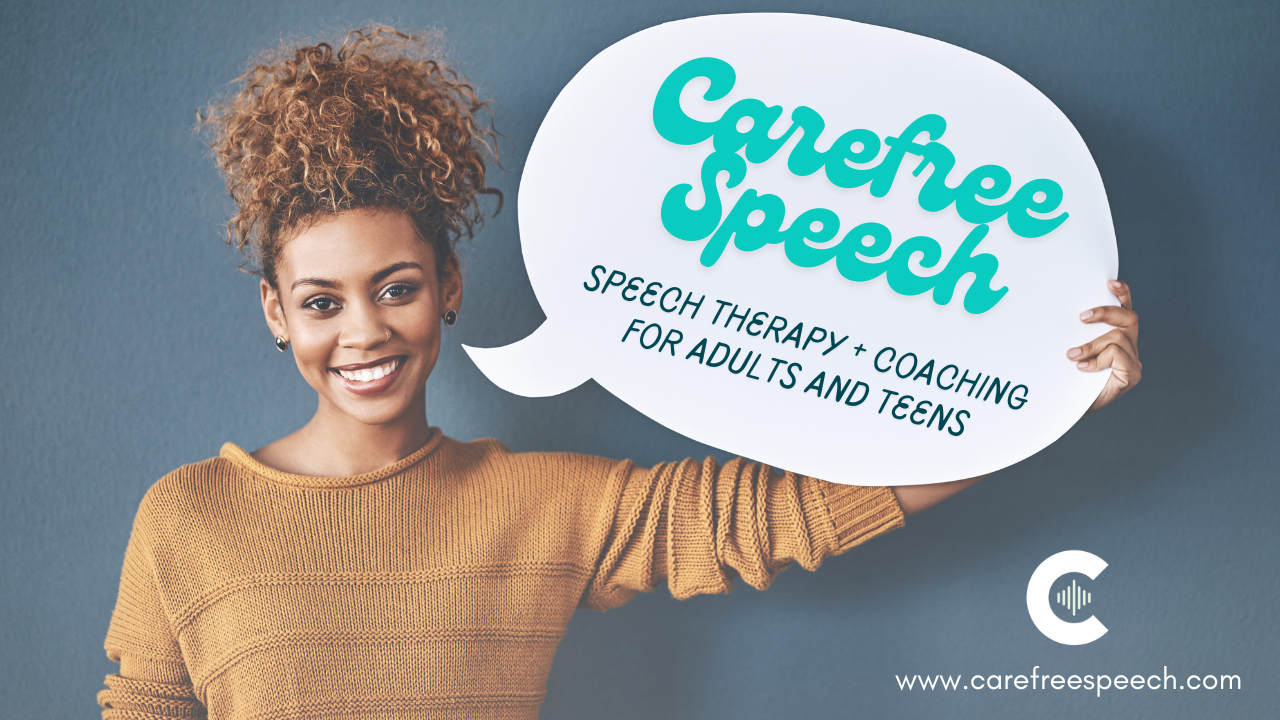Speak Up Without Spiraling: How to Conquer Speaking Anxiety
You know the feeling.
You’ve been rehearsing what to say in your head for the past twenty minutes.
Your palms are sweaty. Your heart’s doing backflips.
Your brain is offline.
Then it’s your turn to speak… and suddenly the words vanish.
Welcome to speaking anxiety. It's more common than people think! And no, you're not "bad at communicating." You're just caught in a stress response, and your nervous system is doing exactly what it's designed to do: protect you from a perceived threat.
The problem is that your brain doesn’t always know the difference between a saber-toothed tiger and a Zoom call. The physiological response to suspected danger is the same, regardless of the type of stimulus.
At Carefree Speech, we work with teens and adults who are smart, thoughtful, and often really good at their jobs. However, they become paralyzed with fear when it's time to speak up.
A man in a suit closes his eyes while rehearsing a presentation.
What is speaking anxiety?
It’s not about “being shy” or needing to “just practice more.” Speaking anxiety is a physical and mental stress response. It’s your brain reacting to the perceived threat of being judged, misunderstood, or put on the spot.
It’s common. Especially for:
Introverts
Neurodivergent professionals
Those who work in high-pressure environments
Anyone who’s had a traumatic or negative public speaking experience in the past
The good news? Speaking anxiety is not a personality flaw. And you don’t have to “fake it till you make it!” Whether you want to more effectively communicate during meetings, small talk, interviews, presentations, or even just ordering coffee, here are three small strategies that can help take the edge off:
1. Exhale Before You Speak
Yes, exhale. Not inhale.
When you’re anxious, your breathing tends to get shallow and stuck in your chest. A quick, intentional breath out helps signal safety to your nervous system. Think of it as a reset button. Even one full exhale before speaking can help ground you in the moment and bring your voice (and brain) back online.
2. Anchor Your Body
If your thoughts are spiraling, try shifting your attention to your body. Press your feet into the ground. Grip the arms of your chair. Wiggle your toes. Anchoring your body physically can help interrupt the panic loop and give your mind a place to land. Here are some additional grounding techniques you might consider trying!
Bonus tip: Sit with both feet flat on the floor during stressful conversations. It sounds small, but your nervous system loves that kind of stability.
3. Have a Script, but Stay Flexible
Spoiler: memorizing your entire script usually backfires, and that reliance on a pre-determined outline often exacerbates speaking anxiety. Instead, jot down a few bullet points or keywords for a rough framework. Having a simple structure helps you stay organized without locking you into a script. Think of it like a map, rather than a GPS that yells at you when you take a detour.
A woman in a white top speaks into a microphone in front of an audience.
You don’t need to sound like a TED Talk. You just need to sound like you.
Speaking anxiety often comes from the pressure to sound polished, confident, or “professional.” But the best communicators aren’t perfect; they’re present and authentic. They sound human.
Ready to stop dreading conversations?
At Carefree Speech, we offer coaching that’s practical, neurodiversity-affirming, and customized for your own unique pace. Whether you're trying to find your voice at work, advocate for yourself in appointments, or just feel less like you're about to pass out every time you unmute… we’ve got you!
We provide 1:1 coaching for teens and adults who are tired of overthinking every word and want communication to feel less like survival and more like self-expression.
💬 Calm your nervous system
💬 Build confidence
💬 Learn practical tools that actually help
📩 Want to work with us?
We offer 1:1 coaching for adults and teens navigating speaking anxiety, communication challenges, and executive function skills. Visit us learn more or book a free consultation.
Woman in a yellow sweater smiling holding a speech bubble that says: “Carefree Speech: Speech Therapy + Coaching for Adults and Teens”




